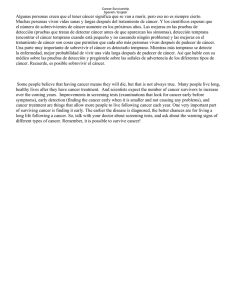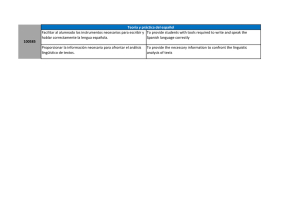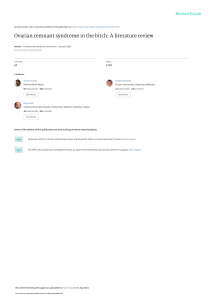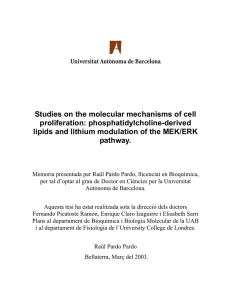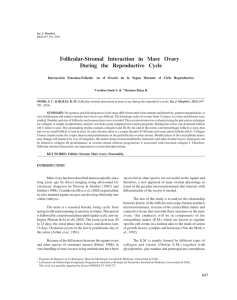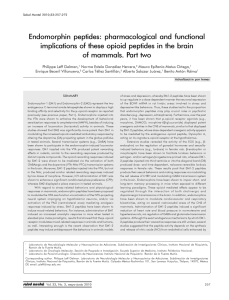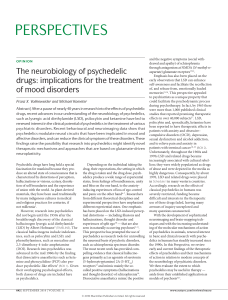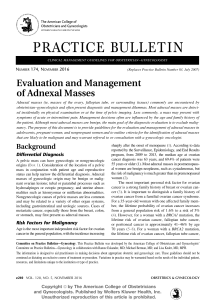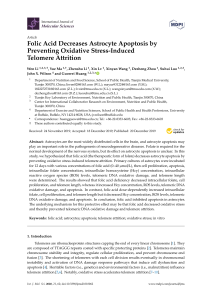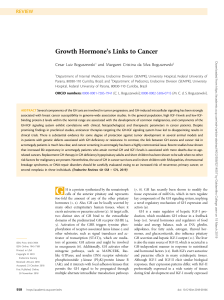Diapositiva 1 - 11 Simposio Oncología Traslacional
Anuncio
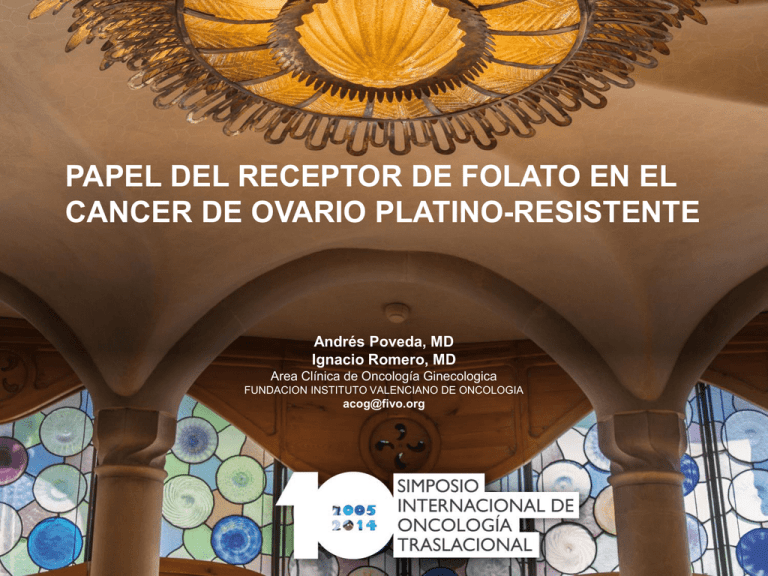
PAPEL DEL RECEPTOR DE FOLATO EN EL CANCER DE OVARIO PLATINO-RESISTENTE Andrés Poveda, MD Ignacio Romero, MD Area Clínica de Oncología Ginecologica FUNDACION INSTITUTO VALENCIANO DE ONCOLOGIA [email protected] 4th Ovarian Cancer Consensus Conference June 25 – 27, 2010 UBC Life Sciences Institute, Vancouver, BC B-2 What are the promising targets for future therapeutic approaches? • The most promising targets in clinical trials are angiogenesis and homologous recombination deficiency. • To select patients for trials investigating these targets, predictive biomarkers are required. Understanding mechanisms of resistance is a priority. • Other promising targets currently being studied based on ovarian cancer biology include: • PI3-Kinase and Ras/Raf pathways • Folate receptor • Immune targets/cytokines, Notch/hedgehog, IGF merit further investigation. • Targeted agents should be studied both as single agents and in combination based on appropriate preclinical data. Origen del folato en humanos FOLATO= vitamina B9 ÁCIDO FÓLICO pteroylmonoglutamic acid ALIMENTACIÓN= FUENTE EXTERNA 60% legumbres + cereales British Journal of Nutrition(2001), 85, Suppl. 2, ENFERMEDADES ASOCIADAS DÉFICIT FOLATO 1) Anemia megaloblástica 2) Malformaciones recién nacido: maduración tubo neural 3) Homocisteinemia (¿?) 1) Acumulación de homocisteina 2) Efectos: factor riesgo cardiovascular: infartos,…. British Journal of Nutrition(2001), 85, Suppl. 2, Folato: Claves Se ingiere (nutrición) Básico en la Síntesis de DNA Parece pueda tener una relación con el tratamiento del cáncer Mecanismos de introducción FOLATO en la célula Substrato Afinidad Localización tisular Mcs Dirección Reduced Folate carrier 5-methyltetrahydrofolate Baja todos iónico bidireccional FRA FOLATO Alta Neoplasia epitelial (no requerido en condiciones normales) Endocitosis Internalización 5-MTH: folato reducido (forma fisiológica mayoritaria) esencial para la metilación génica (asociado a metilación de oncogenes): putativo papel protector en carcinogénesis RFC introduce los fármacos antifolato (MTX, Pemeterexed) posible papel protector en CO (ver estudios supervivencia) Kelemen Int. J. Cancer:119,243–250 (2006) Zhao Expert Opin. Drug Deliv. (2008) 5(3):309-319 Folates can principally be taken up by 2 distinct mechanisms: FR and RFC The reduced folate carrier binds folates with a low affinity (Kd=10-5 M). Folic acid is a very poor substrate. Upon binding to the FR (Kd=10-10 M), folic acid is internalized via endocytosis 2 1 Most antifolates enter cells this way Folic acid binds to the FR with high affinity 3 FR releases folic acid inside the acidic endosome 4 Folic acid escapes endosome and enters cytosol 5 FR recycles back to cell surface Mecanismo de acción del RF: Endocitosis sin lisosomas Folate-SMDCs enter cells via the FR 2 Upon binding to the folate receptor (Kd=1010 M), the conjugate is internalized via endocytosis The reduced folate carrier Binds folates with a low affinity (Kd=10-5 M). Folate conjugates will not enter cell through the reduced folate carrier. most antifolates enter cells this way 1 Folate-conjugate binds the folate receptor 3 The drug is cleaved inside endosome 4 Drug escapes endosome and exerts activity on cell 5 Folate receptor recycles back to cell surface Mecanismos de introducción FOLATO en la célula Substrato Afinidad Localización tisular Mcs Dirección Reduced Folate carrier 5-methyltetrahydrofolate Baja todos iónico bidireccional FRA FOLATO Alta Neoplasia epitelial (no requerido en condiciones normales) Endocitosis Internalización 5-MTH: folato reducido (forma fisiológica mayoritaria) esencial para la metilación génica (asociado a metilación de oncogenes): putativo papel protector en carcinogénesis RFC introduce los fármacos antifolato (MTX, Pemeterexed) posible papel protector en CO (ver estudios supervivencia) Kelemen Int. J. Cancer:119,243–250 (2006) Zhao Expert Opin. Drug Deliv. (2008) 5(3):309-319 La familia de RECEPTORES FOLATO α,β,γ Macrófagos asociados a tumor Forma modificada: mayor afinidad Folato Antony AC. Folate receptors. Ann Rev Nutr 1996;16:501–21. 1. Low. Current Opin Chem Biol. 2009; 13:256-262 Pa e ti c in ea l ar ta ul cr cr do m En ic ec ic st tr ea ar or st ol G Br k ey ng ec dn /N Ki e n NS Lu C in ri a er n/ ad ai Te C He Br va Ut O % FR Expression by IHC Expresión de RFA en cáncer 100 90 80 70 60 50 40 30 20 10 0 Receptor Folato y Cáncer • Expresión en Cáncer de Ovario – Diana en Cáncer de Ovario • Uso como Marcador pronóstico y predictivo de eficacia – Selección de pacientes: Imagen • Aplicación clínica en Cáncer de Ovario – Datos de estudios clínicos: PRECEDENT, PROCEED • Aplicación clínica en otros tumores RFA: Expresión en Cancer de Ovario (IHQ) PRIMARY TUMOUR (72%, infraest) PRIMARY vs RELAPSED (81%) Agreement: 87.3% Resumen: por qué RFA es una diana interesante 1) LOCALIZACIÓN TEJIDO TUMORAL (no en sano) 2) ADQUIRIDO CON LA AGRESIVIDAD cáncer ovario ESTADÍOS AVANZADOS ALTO GRADO 3) Modelos in vitro/ in vivo inhibición inhibe crecimiento 4) MECANISMO ENDOCITOSIS PRESERVA MOLÉCULA ASOCIADA 4th Ovarian Cancer Consensus Conference June 25 – 27, 2010 UBC Life Sciences Institute, Vancouver, BC B-2 What are the promising targets for future therapeutic approaches? • The most promising targets in clinical trials are angiogenesis and homologous recombination deficiency. • To select patients for trials investigating these targets, predictive biomarkers are required. Understanding mechanisms of resistance is a priority. • Other promising targets currently being studied based on ovarian cancer biology include: • PI3-Kinase and Ras/Raf pathways • Folate receptor • Immune targets/cytokines, Notch/hedgehog, IGF merit further investigation. • Targeted agents should be studied both as single agents and in combination based on appropriate preclinical data. Receptor Folato y CAO • Papel del Receptor de Folato – Diana potencial en Cáncer • Expresión en Cáncer de Ovario – Diana en Cáncer de Ovario • Uso como Marcador pronóstico y predictivo de eficacia – Selección de pacientes: Imagen • Aplicación clínica – Datos de estudios clínicos: PRECEDENT, PROCEED Técnicas de imagen mediadas por receptor Etarfolatide • Requirimientos para un agente para imagen nuclear – Alta afinidad para el receptor receptor1: RA de Etarfolatide para FR: 0.92 (acido fólico: 1.0)2 – Selectividad alta: FR sobreexpresado en cáncer1 – Aclaramiento rápido en tejido sano1: t1/2= 25 minutos2 – Buena absorción para contraste1: Etarfolatide molecular weight: 746 kD2 – Estabilidad – Util para diagnóstico y cirugía3 SPECT/ Fluorescencia 1. Sega Cancer and Metastasis Reviews 2008 27 (4) 655-664; 2. Muller. Current Pharmaceutical Design, 2012, 18(8):1058-1082 3. Current Medicinal Chemistry, 2012, 19, 4742-4758 Etarfolatide: Características CO2H H2N N HN O N N H N O O H N O O H N N O N CO2H Tc NH2 S CO2H •Folate-targeted molecular imaging agent •Companion diagnostic to vintafolide •Minimally invasive technique to identify lesions that express folate receptors •Injected into subjects chelated with technetium 99m •Detected by SPECT imaging (single-photon emission computerized tomography) 1. Fisher. J Nucl Med 2008;49:899-906 Etarfolatide: distribución Marrow Liver Kidney Marro w Spleen Bladder FR positive lesions Planar 99mTc-etarfolitide scan Anterior Posterior Utilidad de Ac. Fólico para la calidad de imagen Utilidad de Ac. Fólico para la calidad de imagen Ovarian Cancer Patient 1 Ovarian Cancer Patient 1 Target Lesion No FA pre-injection 0.5 mg IV FA pre-injection Correlación entre TAC y SPECT Inguinal lymph node (1.5 cm- short axis) FR-negative Lesion Conjugados: Aplicación clínica Etarfolatide Cortesía Dr. I. Romero Receptor Folato y Cáncer • Papel del Receptor de Folato – Diana potencial en Cáncer • Expresión en Cáncer de Ovario – Diana en Cáncer de Ovario • Uso como Marcador pronóstico y predictivo de eficacia – Selección de pacientes: Imagen • Aplicación clínica – Datos de estudios clínicos completados: • EC-FV-02 y EC-FV-04 (PRECEDENT) – Estudios clinicos en marcha: PROCEED Aplicación clínica: Conjugados Vintafolide (MK-8109, EC-145) • A small drug conjugate of folate coupled chemically to desacetylvinblastine hydrazide (DAVLBH) that specifically targets the folate receptor (FR). Vlahov, Bioconjugate Chem. 2012; 23(7)1357-1369 Leamon. Int J Cancer 2007; 121:1585-1592 Farletuzumab Current therapeutic approaches in oncology Leamon et al. (2013) Pharmacogenomics and Personalized Medicine 6, 113-125. Tissue Distribution of Etarfolatide and Vintafolide in M109 Tumor-bearing Mice 3H-Vintafolide or Tu m om St M us cl ac h e y id ne K st in e n In te le e Sp ve r Li Lu ng ea r H B t 10 9 8 7 6 5 4 3 2 1 0 lo od % Injected Dose/Tissue (g) Etarfolatide 1. Leamon. Proceedings of the 102nd Annual Meeting of the American Association for Cancer Research; AACR 2012. Abstract nr 3622. Phase I Study of Folate Conjugate Vintafolide in Patients with Refractory Solid Tumors • MTD = 2.5 mg days 1, 3, and 5 and days 15, 17, and 19 of each 28-day cycle. • One ovarian cancer patient with a RECIST-defined partial response (PR) for a period of 111 days. • One ovarian cancer patient with SD for 172 days. • The most commonly reported adverse events were constipation, nausea, fatigue, and vomiting. Constipation was the dose-limiting toxicity. FR status EC20 status was determined from Etarfolatide imaging: – EC20 (100%) • all target lesions EC20 positive (subject score, 100%). – EC20 (10-90%) • at least one EC20-positive lesion but not all target lesions EC20 positive (subject score, 10%-90%). – EC20(0%) • no EC20-positive target lesions with at least one evaluable target lesion (subject score, 0%) – EC20 (?) • no evaluable target lesions (subject score, nonevaluable). Vintafolide in Subjects with Advanced Ovarian Cancer: a Phase II study. Protocol EC-FV-02 Inclusion criteria • Folate receptor (FR) positive platinum resistant or platinum refractory epithelial ovarian, fallopian tube, or primary peritoneal carcinoma • Measurable disease with ≥ 1 target lesion by RECIST 1.0 • ≥ 4 prior chemotherapy regimen • ECOG performance status 0-2 Exclusion criteria • Pregnancy or lactating • Symptomatic central nervous system metastasis • Prior therapy with vinorelbine or other vinca-containing compounds Progression-Free Survival Probability of Progression – Free Survival 1.0 Vintafolide ITT (n=43) Vintafolide ITT≤3 (n=15) 0.9 Progression, n 31 11 0.8 Censored, n 12 4 Median PFS 7.4 15.6 0.7 0.6 • 0.5 64% had 4 previous therapies 0.4 0.3 Vintafolide ITT Vintafolide ITT≤3 0.2 0.1 0.0 0 5 10 15 20 25 30 35 40 45 50 55 60 65 70 Weeks From First Administration of Vintafolide Vintafolide ITT ≤ 3 analysis set = patients in the trial who received three or fewer previous chemotherapy regimen Results: Patients with ≤3 prior therapies FR 100% (N=7) n (%) FR 10-90% (N=6) n (%) FR 0% (N=1) n (%) FR NE (N=1) n (%) Clinical Benefit 1 (14.3) 1 (16.7) 0 (0.0) 0 (0.0) Response Complete Response (CR) Partial Response (PR) Stable Disease (SD) Progressive Disease (PD) 0 (0) 1 (14.3) 5 (71.4) 1 (14.3) 0 (0) 1 (16.7) 2 (33.3) 3 (50) 0 (0) 0 (0) 0 (0) 1 (100) 0 (0) 0 (0) 0 (0) 1 (100) Overall Response (CR+PR) 1 (7.1) 1 (16.6) 0 (0) 0 (0) Disease Control Rate (CR+PR+SD) 6 (85.7) 3 (50) 0 (0) 0 (0) PRECEDENT n= 149 patients Platinum resistant ovarian cancer patients (failed first or second platinum therapy < 6 months) EC20 Scan 2:1 Randomization PRECEDENT: Randomized phase II Study of PLD +/- Vintafolide in PROC Vintafolide + PLD Vintafolide 2.5mg TIW wks 1, 3 PLD=50 mg/m2 (IBW) every 28 days PLD only PLD= 50 mg/m2 (IBW) every 28 days Statistical Analysis: • Designed for 70% power for 0.68 HR for PFS analysis • Stratification by region, line of platinum failure, baseline CA-125 • One pre-specified formal interim efficacy analysis for futility (DSMB) • No protocol modifications following interim analysis Key Inclusion/Exclusion Criteria Inclusion criteria Exclusion criteria • Pathology-confirmed platinum• Borderline tumors resistant ovarian cancer • Prior exposure to PLD, folate receptor• ≥ 1 RECIST-defined measurable lesion targeted therapy, mouse antibodies, (RECIST 1.0—up to 10 lesions) vinorelbine or other vinca-containing • Prior platinum-based chemotherapy compounds but ≤ 2 prior systemic cytotoxic • Other concurrent chemotherapy, regimens (allowed 1 prior line of nonimmunotherapy, radiotherapy, or any cytotoxic therapy) other investigational therapy. • ECOG performance status of 0 to 2 with adequate organ function Primary endpoints Efficacy • Progression-free survival (PFS) Safety Secondary efficacy endpoints • Overall survival (OS) • Correlation between therapeutic response and folate receptor (FR) positivity in the following subgroups: –FR (100%) –FR (10-90%) –FR (0%) Etarfolatide: Subgroup assignment for PRECEDENT Subgroup FR(100%) FR expression % PRECEDENT Population All target lesions 40.4% At least one target lesion 78.7% FR (10-90%) FR(-) At least one, but not all target lesions 38.3% No target lesions 21.3% Primary Endpoint: Progression Free Survival (PFS) Stratification Progression-Free Survival: Subgroup Analysis Vintafolide + PLD PLD Alone HR p-value n PFS (mos) n PFS (mos) (95% CI) Logrank ITT 100 5.0 49 2.7 0.626 (0.409, 0.959) 0.031 FR (10 -100%) 48 5.7 26 1.7 0.547 (0.304, 0.983) 0.041 FR (100%) 23 5.5 15 1.5 0.381 (0.172, 0.845) 0.013 FR (10-90) 25 5.7 11 7.0 0.873 (0.334, 2.277) 0.791 13 3.8 7 5.4 1.806 (0.369, 8.833) 0.468 Population FR (0%) Progression-Free Survival Subgroup Analyses – FR(100%) Variable Median PFS (wk) Hazard Ratio p-value (2-sided Test) Vintafolide + PLD Alone PLD 24.0 6.6 0.387 0.013 Progression-Free Survival Subgroup Analyses FR (0%) Variable Median PFS (wk) Hazard Ratio p-value (2-sided Test) Vintafolide + PLD PLD Alone 16.6 23.3 1.806 0.468 Drug-Related Adverse Reaction Occurring in ≥10% of Patients in Either Treatment Conclusions • Platinum resistant ovarian cancer (PROC) is an orphan indication with high unmet medical need. • The results of PRECEDENT demonstrate statistically significant and clinically meaningful improvement in progression-free survival (PFS) for patients with PROC, with the greatest efficacy in patients where all target lesions where FR positive (FR 100%) • Estudio PROCEED Overall, the safety data suggest that, with appropriate monitoring, vintafolide + FASE III PLD is well tolerated by subjects regardless of their FR status • Vintafolide + PLD demonstrated an overall positive risk-benefit assessment • Improved risk-benefit profile for the FR(100%) subject population • FR(0%) subjects should not be treated with the combination regimen • These results support the use of etarfolatide to identify PROC patients with FR positive disease. 20 March 2014 EMA/CHMP/138539/2014 Committee for Medicinal Products for Human Use (CHMP) Su m m a r y of opin ion 1 ( init ia l a u t hor isa t ion) Vynfinit vintafolide On 20 March 2014, the Committee for Medicinal Products for Human Use (CHMP) adopted a positive opinion, recommending the granting of a conditional marketing authorisation 2 for the medicinal product Vynfinit, intended for the treatment of adult patients with platinum-resistant ovarian cancer who express the folate receptor on all target lesions. Folate receptor status should be assessed by a diagnostic medicinal product approved for the selection of adult patients for treatment with vintafolide, such as Folcepri (see Summary of Opinion on Folcepri). Vynfinit was designated an orphan medicinal product on 9 February 2012. The applicant for this medicinal product is Endocyte Europe, B.V. Vynfinit is to be available as a 2.5 mg powder for solution for injection. The active substance of Vynfinit is vintafolide, which belongs to the therapeutic group ‘vinca alkaloid and analogues’ (L01CA06). Vintafolide consists of folic acid and the cytotoxic agent desacetylvinblastine hydrazide (DAVLBH). The folic acid component enables DAVLBH to be delivered preferentially to cancer cells expressing folate receptors. Once delivered inside cancer cells, DAVLBH is released from vintafolide and acts by inhibiting microtubule assembly and arresting cells in mitosis. The benefits with Vynfinit are its ability, in combination with pegylated liposomal doxorubicin (PLD), to improve progression-free survival in patients with platinum-resistant ovarian cancer when compared with treatment with PLD alone. The most common side effects are fatigue, stomatitis, neutropenia, anaemia, nausea, palmar-plantar erythrodysaesthesia, constipation, rash and peripheral sensory neuropathy. A pharmacovigilance plan for Vynfinit will be implemented as part of the marketing authorisation. The text for the approved indication is as follows: "Vynfinit in combination with pegylated liposomal doxorubicin (PLD) is indicated for the treatment of adult patients with platinum resistant ovarian PROCEED: Phase 3 Study EC-FV-06: PLD +/- Vintafolide in PROC Patients N= 640 patients Platinum resistant ovarian cancer patients (failed first or second platinum therapy < 6 months) Up to 2 prior lines Vintafolide + PLD Receptor Scan 1:1 Vintafolide= 2.5mg TIW wks 1, 3 PLD=50 mg/m2 (IBW) every 28 days PLD + placebo 50 mg/m2 (IBW) every 28 days Same Design as Phase 2 Increased Probability for Success Robust Assessment of PFS (and OS) Clinically Meaningful PFS Improvement •Platinum resistant ovarian cancer •Same dose and schedule •Exclude FR(0%) patients from study •Increase power for OS (85% power for HR= 0.70) •Double-blinded •Radiologic progression only, RECIST v1.1 •Supportive blinded independent review •Primary endpoint on FR 100% •Final PFS analysis = 98% power for HR= 0.60 •Step-down analysis for low FR thresholds Conclusiones • Los receptores folato están sobreexpresados en la mayor parte de los tumores epiteliales. Su sobreexpresión está asociada a un peor pronóstico. • Los RF pueden ser utilizados para transportar al interior de la célula moléculas para uso diagnóstico y terapéutico. • Etarfolatide (conjugado Ac. Fólico con Tc99) ha demostrado alta afinidad para unirse a RF y detectar tumores RF(+) mediante SPECT. • Datos de Fase-II randomizado de Vintafolide (conjugado de Ac. Fólico con una Vinca), en combinación con PLD vs PLD ha demostrado eficacia en el tratamiento del cáncer de ovario platino-resistente. • La eficacia de Vintafolide va asociada a los tumores con mayor porcentaje de RF(+), definido por técnicas de imagen (Etarfolatide - SPECT). • Estudio PROCEED (F III) en cáncer de ovario recurrente, en población resistente, en fase de reclutamiento activo. Let´s go… [email protected]
